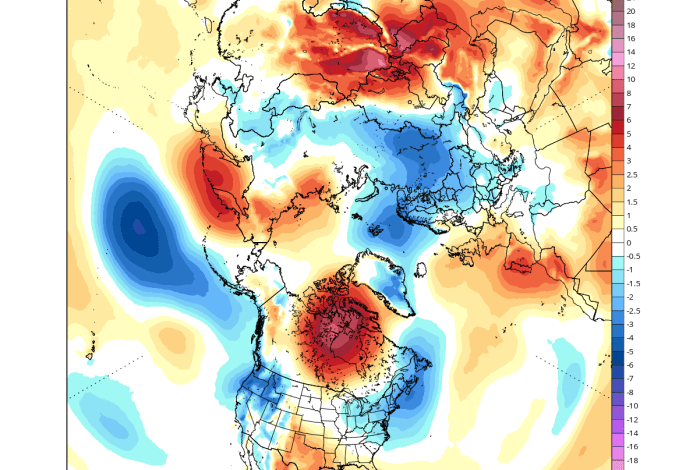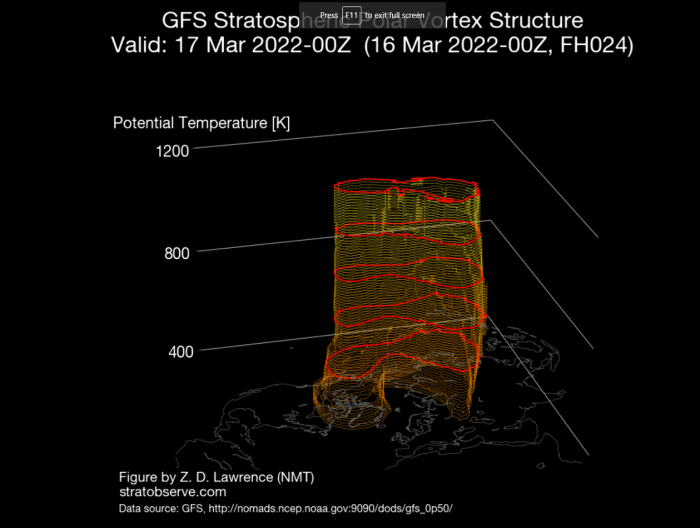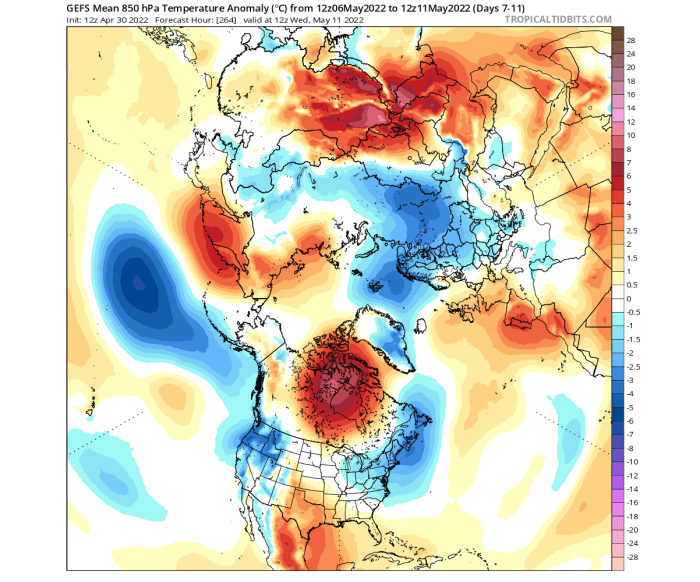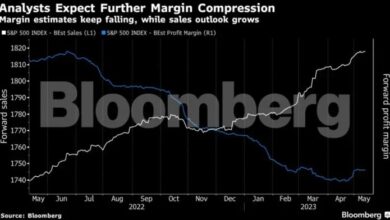
What to know polar vortex collapse? This comprehensive guide delves into the complexities of this fascinating atmospheric phenomenon. We’ll explore its defining characteristics, unraveling the causes behind its collapses, and examining the widespread impacts on weather, ecosystems, and human life. Learn about forecasting methods, preparation strategies, and the interconnectedness of the polar vortex with other atmospheric systems.
From the basic definition of a polar vortex to the intricate mechanisms of its collapse, this article offers a detailed understanding of this significant global weather event. We’ll also examine the role of climate change in influencing polar vortex stability and discuss the implications for future predictions.
Defining the Polar Vortex Collapse
The polar vortex is a large, rotating, low-pressure system of cold air that typically resides over the Earth’s polar regions. Understanding its dynamics is crucial for predicting winter weather patterns, particularly in mid-latitudes. A polar vortex collapse is a significant weakening or disruption of this system, leading to a redistribution of cold air.A polar vortex is a stable atmospheric feature, whereas a polar vortex collapse is a dynamic event characterized by a breakdown of this stability.
The polar vortex itself is a persistent, high-altitude, low-pressure system, circulating air around the poles. A collapse is a disruption of this circulation, causing cold air to spill out from the polar region, potentially bringing frigid temperatures to areas far south of its typical range.
Atmospheric Conditions of a Polar Vortex
The polar vortex is characterized by extremely cold temperatures, strong winds, and a stable atmospheric structure. The air mass is typically isolated from lower latitudes by a strong jet stream, preventing significant mixing with warmer air. These conditions are essential for maintaining the vortex’s integrity and preventing the intrusion of warmer air.
Types of Polar Vortex Collapses
Different types of polar vortex collapses exist, each exhibiting unique characteristics. A complete collapse involves a significant weakening of the vortex, often resulting in a substantial loss of its defining characteristics, like the strong polar jet stream. A partial collapse may involve a weakening of the vortex in specific regions, leading to a less dramatic but still noticeable shift in weather patterns.
Understanding these nuances is essential for accurate forecasting and preparing for potential impacts.
Key Characteristics of a Polar Vortex Collapse
| Characteristic | Description |
|---|---|
| Temperature Anomaly | A significant decrease in temperatures in mid-latitudes, exceeding the historical norms for the region. This deviation is often sudden and dramatic. |
| Jet Stream Weakening/Disruption | The jet stream, a powerful atmospheric current, often weakens or shifts during a collapse. This allows for the displacement of cold air masses into lower latitudes. |
| Polar Air Mass Displacement | Cold air masses from the polar region are expelled into mid-latitudes, potentially causing severe cold snaps and unusual weather patterns. |
| Duration | The duration of a collapse can vary, from a few days to several weeks, impacting the severity and duration of associated cold weather. |
| Geographic Extent | The geographic extent of the collapse can vary widely, affecting areas spanning continents or limited to specific regions. The scope is directly related to the strength of the disturbance. |
Causes and Triggers of Collapse

The polar vortex, a large rotating weather pattern, is a critical component of Earth’s atmospheric circulation. Its weakening and collapse can have significant impacts on global weather patterns, leading to extreme cold spells in mid-latitudes. Understanding the factors that trigger these collapses is essential for predicting and preparing for these events.The polar vortex’s stability is not static. Various factors can influence its strength and ultimately lead to a collapse, a phenomenon that has become increasingly relevant with the ongoing impacts of climate change.
These disruptions can create a ripple effect, impacting weather patterns far beyond the Arctic.
Factors Contributing to Weakening, What to know polar vortex collapse
The polar vortex’s strength is intrinsically linked to the temperature difference between the Arctic and mid-latitudes. A smaller temperature difference weakens the vortex, making it more susceptible to disruptions. This is often exacerbated by atmospheric circulation changes, which can lead to the intrusion of warmer air into the Arctic region, diminishing the temperature contrast. Other factors, such as the jet stream’s behavior, play a crucial role in these shifts.
Role of Jet Stream Disruptions
The jet stream, a powerful current of air high in the atmosphere, acts as a boundary, often guiding the polar vortex. Disruptions in the jet stream’s typical path and speed can lead to the vortex stretching and weakening. These disruptions can be caused by various atmospheric conditions, including blocking patterns, where the jet stream stalls or meanders, allowing cold air to spill south.
These patterns can last for extended periods, significantly impacting weather across large areas.
Impact of Climate Change
Climate change is increasingly recognized as a factor influencing the stability of the polar vortex. The warming Arctic, a consequence of global warming, reduces the temperature difference between the Arctic and mid-latitudes. This reduction in temperature contrast directly weakens the polar vortex, making it more vulnerable to disturbances. Observations from recent decades show a correlation between Arctic warming and increased frequency and severity of polar vortex collapses.
Warming temperatures in the Arctic can destabilize the polar vortex by altering the atmospheric pressure patterns.
Other Potential Triggers
Several other factors can contribute to polar vortex collapses, including solar activity. While the influence of solar activity on the Earth’s atmosphere is complex, changes in solar radiation can potentially affect atmospheric circulation patterns, indirectly influencing the polar vortex. Other potential triggers include large-scale volcanic eruptions, which can inject aerosols into the stratosphere, altering atmospheric temperature profiles. The interplay of these factors contributes to the complexity of predicting and understanding these events.
Summary Table of Causes and Triggers
| Cause | Explanation | Impact |
|---|---|---|
| Temperature Difference Reduction | Decreased temperature difference between the Arctic and mid-latitudes due to Arctic warming. | Weakening of the polar vortex, making it more prone to disruption. |
| Jet Stream Disruptions | Changes in the jet stream’s path and speed, including blocking patterns. | Disturbances in the polar vortex’s structure and leading to its stretching and weakening. |
| Climate Change | Global warming and Arctic warming, which reduce the temperature difference between the Arctic and mid-latitudes. | Increased frequency and severity of polar vortex collapses. |
| Solar Activity | Variations in solar radiation can affect atmospheric circulation. | Potential impact on atmospheric circulation patterns, indirectly influencing the polar vortex. |
| Volcanic Eruptions | Injection of aerosols into the stratosphere. | Altered atmospheric temperature profiles, potentially impacting the polar vortex. |
Impacts and Consequences of Collapse
A polar vortex collapse, while often portrayed as a dramatic event, isn’t a sudden apocalypse. Instead, it’s a significant shift in atmospheric patterns that can have cascading effects on weather, human life, and the environment. Understanding these consequences is crucial for preparing for and mitigating the impacts of such events.
Effects on Weather Patterns
The polar vortex is a large area of low pressure and cold air that typically resides over the Arctic. When it weakens or shifts, cold air can spill southward into mid-latitudes, while warmer air from lower latitudes can intrude further north. This disruption in the usual atmospheric circulation results in a variety of weather anomalies, including prolonged periods of extreme cold in previously temperate regions, sudden temperature drops, and unusual precipitation patterns.
These anomalies can be disruptive to daily life and agricultural practices.
Figuring out what to expect during a polar vortex collapse can be tricky, but it’s important to stay informed. Thankfully, understanding the funeral rites for Pope Francis can offer a similar level of insight into the complexities of handling unexpected events. For a deeper dive into the protocols and traditions surrounding the Pope’s passing, check out this helpful resource: pope francis funeral rites what to know.
Ultimately, whether it’s a global event or a local weather pattern, knowing the details can help us prepare and react more effectively to these moments. So, while you’re researching the polar vortex, keep in mind these important elements.
Extreme Cold in Mid-Latitudes
A weakened polar vortex allows frigid air masses to descend into mid-latitudes, causing significant drops in temperatures. These temperature plunges can have devastating effects on infrastructure, agriculture, and human health. The severity and duration of the cold spell are directly related to the strength and duration of the vortex’s weakening. For instance, the 2021 polar vortex collapse caused extreme cold in parts of the United States, leading to widespread power outages and numerous deaths.
Effects on Human Health, Infrastructure, and Ecosystems
The impacts of a polar vortex collapse extend beyond uncomfortable temperatures. Extreme cold can lead to hypothermia, frostbite, and respiratory illnesses. Infrastructure, such as pipelines, power grids, and transportation systems, can be severely damaged or rendered inoperable. Agriculture can suffer substantial losses, and wildlife populations can be negatively impacted, with some species struggling to survive in the harsh conditions.
Ecosystems can experience a temporary but significant shift in their composition.
Examples of Past Polar Vortex Collapses and Their Consequences
Numerous documented instances of polar vortex collapses have occurred throughout history, showcasing the varied consequences of this atmospheric phenomenon. The 2013-2014 winter saw record-breaking cold in many parts of North America, impacting various aspects of daily life and necessitating widespread emergency measures.
Severity Levels of Collapses and Their Impacts
| Severity Level | Description | Impacts on Weather | Impacts on Human Health | Impacts on Infrastructure |
|---|---|---|---|---|
| Mild | Slight weakening of the vortex, minimal shift in air masses. | Localized cold snaps, minor temperature fluctuations. | Increased risk of hypothermia in vulnerable populations. | Minor disruptions to power grids and transportation. |
| Moderate | Significant weakening of the vortex, substantial shift in air masses. | Extended periods of extreme cold in mid-latitudes, heavy snowfall. | Increased risk of hypothermia and frostbite, respiratory illnesses. | Widespread power outages, damage to transportation systems, and disruptions to agriculture. |
| Severe | Complete or near-complete disruption of the vortex, large-scale movement of air masses. | Record-breaking cold, widespread blizzards, significant disruptions to normal weather patterns. | High risk of hypothermia and frostbite, numerous fatalities. | Widespread infrastructure damage, including power grid collapse, significant damage to transportation systems, and devastating agricultural losses. |
Forecasting and Prediction
Predicting the behavior of the polar vortex, and especially its collapses, is a significant challenge. While scientists have made strides in understanding the complex atmospheric dynamics involved, perfect prediction remains elusive. The inherent chaotic nature of the atmosphere, coupled with the vastness and intricate interactions within the polar region, makes precise forecasting difficult. However, ongoing research and advanced modeling techniques are continuously refining our ability to anticipate these events.
Methods Used to Forecast Polar Vortex Behavior
Atmospheric models, incorporating vast datasets of weather data, are the primary tools used to forecast polar vortex behavior. These models simulate the movement and interaction of air masses, temperature gradients, and pressure systems. Sophisticated numerical methods solve the equations of fluid dynamics, allowing researchers to project the future state of the atmosphere. Initial conditions, derived from current weather observations, are crucial for model accuracy.
Limitations of Current Forecasting Models
Current forecasting models, while powerful, have inherent limitations. The complexity of the atmosphere is immense, and models can only capture a simplified representation of reality. For example, smaller-scale phenomena, like cloud formations or localized temperature fluctuations, may not be accurately represented in the model, leading to uncertainties in the prediction. Furthermore, the polar vortex itself is highly sensitive to initial conditions; even small inaccuracies in these conditions can significantly impact the model’s forecast.
Factors Making Accurate Forecasting Challenging
Several factors make accurate forecasting challenging. The remote location of the polar region and the sparse observational network in the high-latitude atmosphere pose a significant obstacle. Limited data hinders the models’ ability to capture the intricacies of polar atmospheric dynamics. Another critical factor is the influence of external forces, such as changes in solar activity or stratospheric waves, which can impact the polar vortex in unpredictable ways.
Understanding a polar vortex collapse is crucial for preparing for extreme weather. It’s a complex atmospheric phenomenon, but the recent news about the Trump administration’s dealings with energy companies at CeraWeek trump energy companies ceraweek highlights the potential interplay between political decisions and the impact on our climate and weather patterns. Ultimately, staying informed about the science behind these events is key to understanding their real-world consequences.
These factors often introduce uncertainties into the predictions.
How Atmospheric Models Predict Collapses
Atmospheric models simulate the polar vortex’s behavior over time. By inputting current atmospheric conditions, including temperature, pressure, and wind patterns, the model projects how these factors will evolve. The model identifies potential instabilities within the vortex and calculates the likelihood of these instabilities developing into a collapse. These calculations often include the analysis of factors like the strength of jet streams, the location of temperature gradients, and the interplay of atmospheric waves.
For instance, a model might show a weakening jet stream in a particular region, leading to a forecast of vortex weakening or collapse.
Forecasting Models and Their Strengths and Weaknesses
| Model Name | Strengths | Weaknesses |
|---|---|---|
| Global Circulation Models (GCMs) | Comprehensive representation of the entire atmosphere, including the polar region. | Can be computationally expensive, and resolving fine-scale features within the polar vortex may be challenging. |
| Regional Climate Models (RCMs) | Higher resolution over specific regions, potentially improving the representation of polar vortex dynamics. | Limited global coverage, and accurate representation of the large-scale influences on the polar vortex may be lacking. |
| Ensemble Forecasting | Provides a range of possible outcomes, allowing for assessment of uncertainty. | Can be difficult to interpret the spread of the ensemble predictions. |
Different forecasting models employ varying levels of resolution and complexity, leading to varying degrees of accuracy. Each model has its strengths and weaknesses, and their combined use can provide a more comprehensive picture of potential polar vortex behavior.
Preparing for and Responding to a Collapse: What To Know Polar Vortex Collapse
A polar vortex collapse can bring devastatingly low temperatures, significantly impacting daily life and infrastructure. Understanding how to prepare and respond is crucial for mitigating the risks and ensuring safety. This section provides strategies for individual and community preparedness, outlining actions to take before, during, and after such an event.Preparing for a polar vortex collapse isn’t about predicting the exact date or time; it’s about building resilience and readiness.
By taking proactive steps, individuals and communities can significantly reduce the impact of these extreme weather events. The strategies Artikeld here focus on minimizing risks and maximizing safety during and after a collapse.
Mitigating the Impact of Extreme Cold
Protecting oneself from extreme cold requires a multi-faceted approach. Essential supplies and precautions are crucial for maintaining well-being. Prioritizing warmth, food, and water security is paramount.
- Dress in layers: Wearing multiple layers of clothing, including thermal underwear, fleece jackets, and waterproof outer layers, traps warm air and provides insulation. Avoid cotton, as it absorbs moisture and loses its insulating properties when wet.
- Insulate your home: Seal gaps and cracks around windows and doors to prevent drafts. Use blankets, curtains, or other materials to insulate your home, reducing heat loss.
- Protect vulnerable populations: Elderly individuals, young children, and those with pre-existing health conditions are particularly vulnerable to extreme cold. Ensure their needs are met with extra care and support.
- Utilize warming devices safely: Use space heaters, fireplaces, and other warming devices cautiously. Never leave them unattended and keep flammable materials away from heat sources.
Protecting Infrastructure During a Collapse
Infrastructure protection is crucial to maintaining essential services during a polar vortex collapse. The following measures will help safeguard critical systems.
Understanding a polar vortex collapse involves knowing how drastically shifting weather patterns can impact us all. While this is a significant concern, it’s important to also consider the broader societal shifts happening, like the movement towards returning US public lands to indigenous people, as detailed in this article us public lands return indigenous people. These complex issues highlight the interconnectedness of environmental and social factors, and ultimately, a deeper understanding of how our actions affect the world around us.
Ultimately, the polar vortex collapse is a complex issue requiring multifaceted consideration.
- Insulate critical pipelines: Insulating pipelines and other critical infrastructure, such as water mains and power lines, can prevent damage from freezing.
- Maintain emergency power sources: Ensure backup power sources, like generators or solar panels, are operational and ready for use. This is essential to keep essential services running.
- Prepare for potential power outages: Stock up on essential supplies like flashlights, batteries, and communication devices in case of prolonged power outages. Have a plan for alternative lighting and heating.
The Role of Emergency Response Teams
Emergency response teams play a vital role in mitigating the impacts of a polar vortex collapse. Their actions are crucial for rescuing people and restoring essential services.
- Rapid response and evacuation: Emergency response teams are trained to respond rapidly to situations and evacuate those at risk. This includes identifying and assisting vulnerable individuals.
- Resource allocation and distribution: Effective resource allocation and distribution is crucial for ensuring essential supplies are reaching those in need.
- Coordination and communication: Coordination and communication between various agencies are essential for a cohesive and effective response.
Individual Preparedness Guide
This step-by-step guide Artikels individual actions for preparing for a polar vortex collapse.
| Action | Rationale | Resources |
|---|---|---|
| Create a comprehensive emergency kit | Contains essential supplies for survival during a polar vortex collapse. | Local retailers, online stores |
| Develop an evacuation plan | Ensures safe and orderly departure in case of severe weather. | Local emergency management agencies |
| Identify and prepare for vulnerable populations | Prioritize the needs of those most at risk during extreme cold. | Local social services, community organizations |
| Stock up on essential supplies | Ensures availability of food, water, and other necessities during the event. | Local grocery stores, pharmacies |
Visualizing the Phenomena
The polar vortex, a large rotating pool of cold air, is a crucial component of Earth’s weather patterns. Understanding its behavior, and particularly its collapse, requires visualizing its dynamic characteristics. Visual representations allow us to grasp the intricate processes and consequences of this atmospheric phenomenon.
Visual Characteristics of a Polar Vortex
The polar vortex is typically characterized by a large, circular swirling pattern of air high in the atmosphere, primarily over the Arctic and Antarctic regions. This swirling motion is primarily due to the Earth’s rotation, which creates a Coriolis effect. The vortex’s boundaries are often fuzzy, and the air within it is extremely cold. Visualizations often depict it as a large, somewhat oval-shaped area of low pressure.
Visualizing the Collapse
A polar vortex collapse isn’t a sudden, complete disappearance. Instead, it involves a weakening and distortion of the vortex’s structure. This weakening allows the cold air to spill out of the polar region, often in a less organized, more fragmented pattern. The resulting changes in atmospheric pressure patterns are visually noticeable in weather maps and satellite imagery. Satellite images, in particular, can highlight the shift in the boundary between cold polar air and warmer air masses.
Observing the Phenomena
The polar vortex and its collapse are observed using various tools and technologies. Weather maps, which show isobars (lines of equal atmospheric pressure), are crucial for visualizing the shifting pressure patterns associated with a collapsing vortex. Satellite imagery provides a broader perspective, capturing the vortex’s overall shape and extent, and highlighting the movement of air masses. Sophisticated computer models can simulate the vortex’s behavior, providing a dynamic visualization of its evolution over time.
Patterns of Air Circulation
During a polar vortex collapse, the typical circular air circulation within the vortex weakens. The cold air masses that once resided within the polar region begin to spread out, sometimes reaching much further south. This disruption in the normal air circulation patterns can lead to significant temperature changes in mid-latitude regions, as warmer air masses are pushed further north.
The change in air circulation is readily apparent on weather maps that display wind patterns and pressure gradients.
Visualizations of the Phenomena
| Visualization | Type | Application |
|---|---|---|
| Weather maps (isobars, isotherms) | Static, graphical | Illustrating pressure gradients and temperature differences; showing the extent of cold air masses. |
| Satellite imagery (infrared, visible light) | Dynamic, visual | Capturing the shape and movement of the vortex, identifying temperature variations across regions. |
| Computer models (numerical weather prediction) | Dynamic, simulated | Visualizing the vortex’s evolution over time, exploring the interactions between air masses, and forecasting its behavior. |
Understanding Related Concepts

The polar vortex isn’t an isolated weather phenomenon. It’s intricately linked to other atmospheric features, and understanding these connections is crucial to comprehending its behavior and impacts. From the jet stream’s role in guiding air masses to the influence of pressure systems, these interconnected elements paint a more complete picture of the polar vortex’s function in the global weather system.The complex dance of air pressure, temperature gradients, and wind patterns creates a dynamic interplay that can lead to significant shifts in weather conditions.
Understanding these relationships allows for more accurate forecasting and a deeper appreciation for the intricate processes at play in our atmosphere.
The Connection Between the Polar Vortex and Jet Stream
The polar vortex and the jet stream are intrinsically linked. The jet stream is a powerful, high-altitude wind current that encircles the globe. It’s often described as a “river” of air, and its path is largely influenced by the temperature differences between the polar regions and lower latitudes. The polar vortex, a large area of low pressure and cold air circling the poles, is a key driver of the jet stream’s position and strength.
Changes in the vortex’s shape and intensity directly impact the jet stream’s path, leading to shifts in weather patterns across the globe. A weakening or disruption of the polar vortex can cause the jet stream to become more erratic and meandering, leading to extreme weather events.
The Role of Atmospheric Pressure Systems
Atmospheric pressure systems, characterized by areas of high and low pressure, play a critical role in shaping the polar vortex and its behavior. High-pressure systems tend to be associated with stable weather, while low-pressure systems are often associated with storm activity. The interplay between these systems and the polar vortex is complex, with low-pressure systems sometimes influencing the vortex’s shape and intensity.
These interactions can trigger shifts in the jet stream’s path and lead to variations in weather patterns. The strength and position of these pressure systems, combined with the temperature contrast between the poles and lower latitudes, are crucial factors determining the polar vortex’s behavior.
The Relationship Between the Polar Vortex and Global Weather Patterns
The polar vortex’s influence on global weather patterns is profound. Its stability or instability directly affects the path and strength of the jet stream, which in turn dictates the movement of weather systems across the globe. A strong and stable polar vortex generally leads to more predictable weather patterns, while a weakened or disrupted vortex often results in more erratic and extreme weather events.
This includes prolonged periods of cold or warmth in certain regions, as well as increased occurrences of storms and other severe weather phenomena.
Comparing and Contrasting the Polar Vortex with Other Atmospheric Phenomena
While the polar vortex is a distinct atmospheric feature, it shares some similarities and differences with other phenomena. For instance, the jet stream, as discussed earlier, is intrinsically linked to the polar vortex. Other notable differences include the spatial scale of these phenomena. The polar vortex is a large-scale phenomenon encompassing the polar regions, while phenomena like tornadoes or hurricanes are localized events.
Furthermore, the time scales for their occurrence vary considerably. The polar vortex’s behavior unfolds over weeks or months, while the development and dissipation of other phenomena like thunderstorms can occur within hours. Understanding these distinctions helps in accurate forecasting and assessment of the impact of each.
Interconnectedness of Concepts
| Concept | Connection to Polar Vortex | Impact on Global Weather |
|---|---|---|
| Polar Vortex | A large area of low pressure and cold air circling the poles. | Stability or instability directly affects jet stream, influencing global weather patterns. |
| Jet Stream | High-altitude wind current influenced by the temperature difference between poles and lower latitudes. | Its path and strength are determined by the polar vortex, leading to predictable or erratic weather. |
| Atmospheric Pressure Systems | High and low-pressure systems interact with the polar vortex, impacting its shape and intensity. | Influence the movement of weather systems and affect weather conditions. |
| Global Weather Patterns | The polar vortex is a primary driver of global weather patterns, influencing temperature and storm activity. | Predictability or unpredictability of weather patterns is directly related to the stability of the polar vortex. |
Final Conclusion
In conclusion, understanding polar vortex collapses is crucial for anticipating and mitigating their impacts. The complex interplay of atmospheric factors, climate change, and forecasting challenges make it a dynamic area of research. By equipping ourselves with knowledge and preparedness strategies, we can better navigate the effects of these significant weather events. This exploration highlights the interconnectedness of atmospheric phenomena and the importance of ongoing research to refine our predictions and responses.





